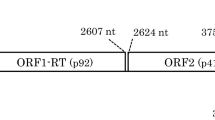Abstract
The complete genome sequence of Stellaria aquatica virus B (StAVB), a new member of the genus Polerovirus that infects Stellaria aquatica, was determined using high-throughput RNA sequencing with confirmation by Sanger sequencing. The complete StAVB genome (GenBank accession no. OP389993) is 5,900 nucleotide (nt) long with seven open reading frames (ORF0–5 and ORF3a) that encode putative proteins (P0–P5 and P3a) in a similar configuration to that of other typical poleroviruses. Pairwise sequence comparisons with other poleroviruses showed 38–50% nt sequence identity in the complete genome and 13–24%, 36–45%, 7–68%, and 6–50% amino acid sequence identity in (aa), for the P0, P1–2, P3, and P4 protein, respectively. These data, together with the results of phylogenetic analysis, indicate that StAVB should be classified as a new member of the genus Polerovirus, family Solemoviridae.


Similar content being viewed by others
Data availability
The datasets generated during and/or analysed during the current study are available from the corresponding author on reasonable request.
References
Sõmera M, Fargette D, Hébrard E et al (2021) ICTV virus taxonomy profile: solemoviridae 2021. J Gen Virol. https://doi.org/10.1099/jgv.0.001707
Gray S, Gildow FE (2003) Luteovirus-aphid interactions. Annu Rev Phytopathol 41:539–566. https://doi.org/10.1146/annurev.phyto.41.012203.105815
Gray’s new manual of botany (7th ed.—illustrated) A handbook of the flowering plants and ferns of the central and northeastern United States and adjacent Canada
Oladeji OS, Oyebamiji AK (2020) Stellaria media (L.) Vill.—a plant with immense therapeutic potentials: phytochemistry and pharmacology. Heliyon 6:150. https://doi.org/10.1016/j.heliyon.2020.e04150
Cho H-D, Kang W-S, Kim D-H et al (2019) Comparison of biological activity between Stellaria aquatica seed extracts. Korean J Food Preserv 26:228–237. https://doi.org/10.11002/kjfp.2019.26.2.228
Sastry KS, Mandal B, Hammond J, et al (2019) Stellaria spp. (Stellaria aquatica, S. media) (Chickweed) BT—encyclopedia of plant viruses and viroids. In: Sastry KS, Mandal B, Hammond J, et al (eds) Springer India, New Delhi, pp 2501–2503
Mertelik J, Mokra V, Gotzova B, Gabrielova S (2000) First Report of Impatiens necrotic spot virus in the Czech Republic. Plant Dis 84:1045. https://doi.org/10.1094/PDIS.2000.84.9.1045B
Kil E-J, Byun H-S, Kim S et al (2015) Tomato yellow leaf curl virus Can Overwinter in Stellaria aquatica, a Winter-Hardy TYLCV-Reservoir Weed. Plant Dis 99:588–592. https://doi.org/10.1094/PDIS-04-14-0352-RE
Gudeta WF, Igori D, Belete MT et al (2022) Complete genome sequence of pueraria virus A, a new member of the genus Caulimovirus. Arch Virol 167:1481–1485. https://doi.org/10.1007/s00705-022-05431-9
Igori D, Kim SE, Kwon S, Moon JS (2022) Complete genome sequence of Plantago asiatica virus A, a novel putative member of the genus Polerovirus. Arch Virol 167:219–222. https://doi.org/10.1007/s00705-021-05265-x
Lotos L, Efthimiou K, Maliogka VI, Katis NI (2014) Generic detection of poleroviruses using an RT-PCR assay targeting the RdRp coding sequence. J Virol Methods 198:1–11. Doi: https://doi.org/10.1016/j.jviromet.2013.12.007
Smirnova E, Firth AE, Miller WA et al (2015) Discovery of a small non-AUG-initiated ORF in poleroviruses and luteoviruses that is required for long-distance movement. PLoS Pathog 11:e1004868. https://doi.org/10.1371/journal.ppat.1004868
Zhang X-Y, Zhao T-Y, Li Y-Y et al (2018) The conserved Proline18 in the Polerovirus P3a is important for brassica yellows virus systemic infection. Front Microbiol 9:613. https://doi.org/10.3389/fmicb.2018.00613
Gudeta WF, Belete MT, Igori D et al (2022) Complete genome sequence of cnidium closterovirus 1, a novel member of the genus Closterovirus infecting Cnidium officinale. Arch Virol. https://doi.org/10.1007/s00705-022-05448-0
Moreno AB, López-Moya JJ (2020) When viruses play team sports: mixed infections in plants. Phytopathology 110:29–48. https://doi.org/10.1094/PHYTO-07-19-0250-FI
Acknowledgements
This research was supported by the Korea Research Institute of Bioscience and Biotechnology (KRIBB) Research Initiative Program (KGS1002213). We thank Jeremy Allen, PhD, from Edanz (www.edanz.com/ac) for editing a draft of this manuscript.
Author information
Authors and Affiliations
Corresponding author
Ethics declarations
Conflict of interest
All authors declare no conflict of interest
Ethical approval
This article does not contain any studies with animals or human participants performed by any of the authors
Additional information
Handling Editor: Ralf Georg Dietzgen.
Publisher's Note
Springer Nature remains neutral with regard to jurisdictional claims in published maps and institutional affiliations.
Supplementary Information
Below is the link to the electronic supplementary material.
Rights and permissions
Springer Nature or its licensor (e.g. a society or other partner) holds exclusive rights to this article under a publishing agreement with the author(s) or other rightsholder(s); author self-archiving of the accepted manuscript version of this article is solely governed by the terms of such publishing agreement and applicable law.
About this article
Cite this article
Gudeta, W.F., Shin, AY., Kim, S.E. et al. Complete genome sequence of Stellaria aquatica virus B, a novel polerovirus that infects Stellaria aquatica. Arch Virol 168, 22 (2023). https://doi.org/10.1007/s00705-022-05687-1
Received:
Accepted:
Published:
DOI: https://doi.org/10.1007/s00705-022-05687-1




